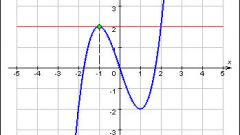Instruction
1
A power series is a special case of the functional series. It is of the form 0+c1(z-z0)+c2(z-z0)^2+...+cn(z-z0)^n+... . (1)If you make the substitution x=z-z0, then this number will take the form c0+c1x+c2x^2+...+cn(x^n)+... . (2)
2
In this case, the rows of the form (2) more convenient for consideration. It is obvious that any power series converges when x=0. The set of points where the series converges (region of convergence) can be found based on the theorem of Abel. It follows from this that if the series (2) converges at the point x0≠0, then it converges for all x satisfying the inequality |x|
3
Accordingly, if at some point x1, the series diverges, this is observed at all x for which |x1|>|b|. Illustration Fig.1, where x1 and x0 is chosen greater than zero, allows us to understand that all of x1>x0. Therefore, when the convergence will inevitably arise the situation x0=x1. In this case, the situation with convergence, with the passage of the merged points (let's call them R and R) changes abruptly. Because geometrically the length R, the number R≥0 is called the radius of convergence of power series (2). The interval (-R,R) is called the interval of convergence of power series. Possibly R=+∞. At x=±R, the series becomes a numerical analysis is made on the basis of information about the numeric ranks.
4
To determine R, the number is examined for absolute convergence. That is, a series of the absolute values of the members of the original series. Research can be conducted on the basis of characteristics d'alembert and Cauchy. In their application limits are found, which are compared with unit. Therefore, the limit equal to unity is achieved when x=R. When the decision on the basis of the d'alembert found the first limit, shown in Fig. 2A. A positive number x at which this limit is equal to one, will be the radius R (see Fig. 2b). In the study of number in the radical sign by Cauchy formula for the calculation of R takes the form (see Fig. 2c).
5
The formula is shown in Fig. 2 shall apply, provided that the limits exist. For the power series (1) the interval of convergence is written as (z0-R, z0+R).




